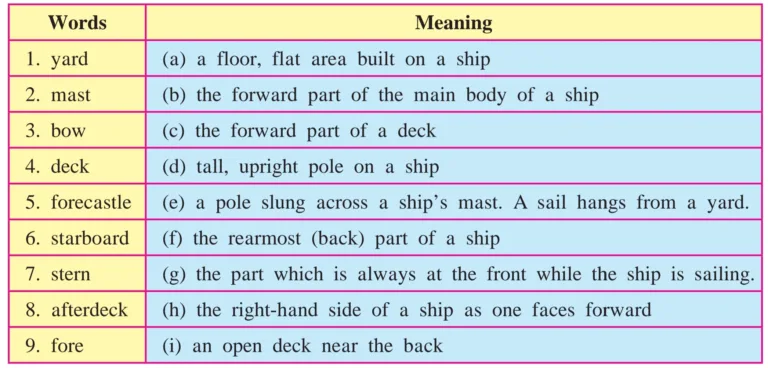Chapter 2.6 – Chasing The Sea Monster
frigate : small, speedy ship used in war
unearthly : strange, not like those found on earth
luminous : bright, full of light
fearsome : scary, frightening
crew : people working on the ship
cetaceans : marine animals like a whale
lurking : hiding
whaling gear : equipment used to hunt whales sail at full speed
steal off : move away
mate : assistant
armour : protective metal covering
profound : deep
IN BETWEEN THE LESSON
Think and answer :
Q1. What is the name of the narrator?
Ans: The name of the narrator is Professor Aronnax.
Q2. What is the name of the ship?
Ans: The name of the ship is the Abraham Lincoln.
Q3. At what time is this event taking place?
Ans: The event is taking place at night.
Q4. Guess and write the meaning of :
(i) astern to port (Use the picture on page 48.)
Ans: toward the rear of a ship.
(ii) blunderbusses
Ans: short guns that have a barrel which is larger at the end.
(iii) duck guns
Ans: guns with exploding bullets that can kill even the most powerful animals.
(iv) harpoon
Ans: a long, sharp weapon attached to a long rope and thrown by hand or shot from a gun.
Q4. Guess the meaning of :
(i) cannoneer
Ans: one who fires the cannon.
(ii) harpooner
Ans: one who throws the harpoon.
Q5. Guess what order the Commander must have given.
Ans: The Commander must have ordered his crew to approach the animal silently and try to kill it.
Q6. Guess the meaning of :
(i) enormous
Ans: great in size, number, or degree.
(ii) hideous
Ans: ugly or unpleasant
ENGLISH WORKSHOP
1. From the passage, find all the words and phrases used to describe the ‘monster’.
Ans: unearthly animal, fearsome a creature, unknown creature, the animal, a huge glowworm, cetacean, a whale, the thing in question, a long, blackish, quivering body, the animal, sea animal cetacean, infernal beast, motionless animal.
2. Form groups of 4. Find all the references to time given in the passage. Then make a chart to show the events described in the passage along with the time when they occur.
Example:
All night long: The crew stayed on their feet.
Near midnight: __________
At 12.53: __________
(Use as many lines as you need.)
Ans:
All night long: The crew stayed on their feet.
Near midnight: The monster disappeared.
At 12.53: A deafening hiss could be heard.
At 2 a.m.: The core of light appeared.
From 2 a.m. till daylight: The crew stayed alert.
At 6 a.m.: Daybreak; the animal’s electric glow disappeared.
At 7 a.m.: Dense morning mist spread around the frigate.
At 8 a.m.: The mist rolled away, the animal was spotted: the battle started.
8 a.m. onwards for about 2 hours: Abraham Lincoln chases the animal.
After 2 hours, till 10.50 p.m.: More direct methods used: cannons fired. Chase continues tirelessly, hour after hour.
At 10.50 p.m.: Reappearance of electric light. The frigate approaches the monster. Ned Land launches the harpoon: hideous collision between the frigate and the monster.
3. How long does the whole event described in this passage take ? Work it out by reading the passage.
Ans: The whole event takes about 24 to 26 hours.
4. Observe the picture and the labels carefully. Then match the words and the meanings given in the following table.


Ans:
1. yard – (e) a pole slung across a ship’s mast. A sail hangs from a yard.
2. mast – (d) tall, upright pole on a ship.
3. bow – (g) the part which is always at the front while the ship is sailing.
4. deck – (a) a floor, flat area built on a ship.
5. forecastle – (c) the forward part of a deck.
6. starboard – (h) the right-hand side of a ship as one faces forward.
7. stern – (f) the rearmost (back) part of a ship.
8. afterdeck – (i) an open deck near the back.
9. fore – (b) the forward part of the main body of a ship.
5. Form groups of 4-5. Read the following sentences aloud. Using your imagination and with the help of group discussion, write other situations in which the sentences can be used.
(i) The outcome: disappointment and anger.
Ans: The students wanted to meet the minister and waited continuously outside his office for three days. Finally the secretary informed them that the minister was on a long foreign trip. The outcome: disappointment and anger
(ii) The hour of battle had sounded
Ans: The two warring teams faced each other aggressively. Both wanted desperately to win. The hour of battle had sounded.
(iii) What a chase !
Ans: I watched the lion chase the deer in and out through bushes and trees for over an hour before it gave up. What a chase!
(iv) This was our chance, ……..
Ans: The Principal asked us if we had any problems or complaints. We thought of our daily burden of homework. Should we complain now? This was our chance…..
6. Find the different units of measurement mentioned in the passage and get more information about them from the internet.
Ans: Students must do this on their own.
7. Language Study : Transitive and intransitive verbs :
We can classify verbs into two types – transitive and intransitive. Some verbs need on object/ objects. When a verb has an object, it is a transitive verb. For example, ‘The boy kicked the football’. Here the verb ‘kick’ has ‘the football’ as its object. ‘Give’, ‘cook’, ‘buy’ are transitive verbs.
Some verbs do not need any objects. When a verb does not have an object, it is an intransitive verb. For example, ‘We laughed loudly’. The verb ‘laugh’ in this sentence does not have an object. ‘Laugh’, ‘walk’, ‘cry’ are intransitive verbs.
Some verbs can be transitive or intransitive.
For example:
‘Birds fly’. (intransitive)
‘Children fly kites’. (transitive)
